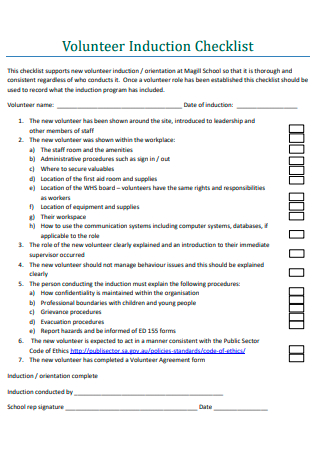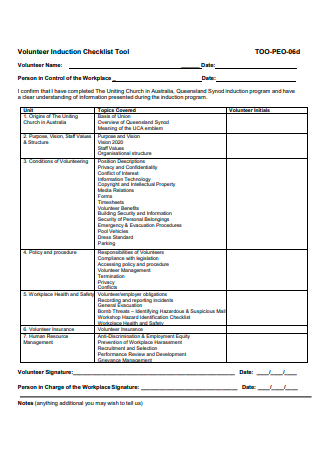21+ Sample Volunteer Induction Checklist
-

Volunteer Induction Checklist Template
download now -

Volunteer Induction Checklist Example
download now -

Tuckshop Volunteer Induction Checklist
download now -

Formal Volunteer Induction Checklist
download now -

Volunteer Induction Checklist in PDF
download now -

Ponds Volunteer Induction Checklist
download now -

Football Club Volunteer Induction Checklist
download now -

Standard Volunteer Induction Checklist
download now -

Draft Volunteer Induction Checklist
download now -

Council Volunteering Induction Checklist
download now -

Volunteer Enrolment and Induction Checklist
download now -

Printable Volunteer Induction Checklist
download now -

Basic Volunteer Induction Checklist
download now -

Volunteer Induction Checklist Tool
download now -

Simple Volunteer Induction Checklist
download now -

Volunteer Visitor Induction Checklist
download now -

Volunteer Induction Checklist Format
download now -

Volunteer Working Induction Checklist
download now -

Sample Volunteer Induction Checklist
download now -

Canteen Volunteer Induction Checklist
download now -

COVID Vaccination Clinic Volunteer Induction Checklist
download now -

Volunteer Induction Checklist in DOC
download now
FREE Volunteer Induction Checklist s to Download
21+ Sample Volunteer Induction Checklist
What Is a Volunteer Induction Checklist?
Benefits of Volunteering
Ways to Volunteer
How to Create a Volunteer Induction Checklist
FAQs
What should be included in an induction checklist?
How do I write a volunteer policy?
What are the 3 main types of induction training?
What Is a Volunteer Induction Checklist?
A volunteer induction checklist is a detailed and comprehensive checklist used to keep track of the different roles and tasks of volunteers. It is similar to a new hire on-boarding checklist; but instead of employees, volunteers are involved.
According to an online article by CNN, about 25% of Americans take the time to volunteer. The average time spent volunteering per year was 52 hours. The same article also presented data revealing that at 27.8%, women volunteered more than men. Whereas men only accounted for around 21.8%.
Benefits of Volunteering
The act of volunteering can bring about many positive effects and benefits. The term ‘helper’s high’ is no coincidence. When people volunteer purely for the sake of helping others, it can bring about a feeling of positive well-being and meaningful purpose. The following examples are just some primary benefits of volunteering.
Ways to Volunteer
There are many ways to help out and volunteer. All you need to do is find something that suits your interests and needs. You might also want to consider your schedule, especially if you have a full-time job or have other important commitments to attend to. The following examples are just some classic ways you can get out of your way and reach out to others.
How to Create a Volunteer Induction Checklist
To create a volunteer induction checklist, you need a firm grasp of what you expect the volunteers to do. And if you need a quick but reliable template for reference, you can easily download a sample template from the collection above. Pick one that suits your needs or preferences and follow the basic steps below.
Step 1: Establish a Format
The first step in creating a volunteer induction checklist is to decide on a format. Since it is a checklist, you can choose to incorporate a traditional checklist with numbers and boxes. Make sure to organize it in a clear and defined way. Arrange the numbers and entries neatly and make sure the checkboxes are sufficient in size. Again, you have the freedom to decide on the fine details of the format. You can choose to use bullet points, check boxes, and other symbols for your checklist. Keep your document to a maximum of a couple of pages. Checklists are meant to be brief and straightforward.
Step 2: Define the Roles
The next step after deciding on a format is to define the roles of the volunteer. The content of this section would depend on the kind of volunteer work required, of course. What is expected of the volunteer? What responsibilities will be awarded to them? It is important to be specific and clear when defining the responsibilities. Volunteer work can cover a wide range of functions, so identifying the scope of work and its limitations are crucial. Examples of roles could include coordination, recruitment, or even supervisory roles.
Step 3: Outline the Tasks
This section is essentially an extension of the previous one. It contains and enumerates the various tasks related to the role of the volunteer. List the tasks individually and be sure to use action-based language. You can arrange them in numeral order or in bullet points. What matters is that there is a logical flow of ideas and the reader is properly guided. Tasks can range from arranging, preparing, coordinating, evaluating, to fundraising. If you need help in this section, you can refer to the sample templates found above for more ideas. Simply find a template that meets your needs and edit it the way you want.
Step 4: Note Other Reminders
The last step for crafting a volunteer induction checklist is to list down any other important reminders. An officer may need a guide or reference on how to conduct the proper induction of new volunteers for a particular program or event. This section is dedicated entirely for such; whether it involves planning, preparation, process or procedure, these reminders are meant to help you stay on top of things. You can note these reminders in plain bullet points or whatever format you prefer.
FAQs
What should be included in an induction checklist?
An induction checklist ought to include specifics pertaining to the volunteer’s roles, tasks, activities and any other important reminders that could help the volunteer transition better into his or her role.
How do I write a volunteer policy?
To write a volunteer policy, you need to establish a directive and a purpose. Volunteers would want to know some background on what they will be engaging and more importantly, their role in it. Refer to the previous section for more detailed instructions on how to create a volunteer induction checklist.
What are the 3 main types of induction training?
According to an article published on ShareYourEssays, there are three main types of induction training. These are general induction programs, specific orientation programs and follow-up induction programs.
A volunteer induction checklist should not just be comprehensive, it should also help you keep track or enable you to stay on top of things. Browse the wide selection of sample checklists above to get started on your own volunteer induction checklist today!
